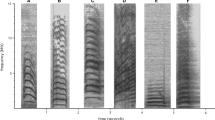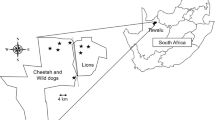Abstract
Redfronted lemurs (Eulemur fulvus rufus) and Verreaux's sifakas (Propithecus verreauxi verreauxi) occur sympatrically in western Madagascar. Both species exhibit a so-called mixed alarm call system with functionally referential alarm calls for raptors and general alarm calls for carnivores and raptors. General alarm calls also occur in other contexts associated with high arousal, such as inter-group encounters. Field playback experiments were conducted to investigate whether interspecific recognition of alarm calls occurs in both species, even though the two species rarely interact. In a crossed design, redfronted lemur and sifaka alarm calls were broadcast to individuals of both species, using the alarm call of chacma baboons (Papio cynocephalus) as a control. Both species responded with appropriate escape strategies and alarm calls after playbacks of heterospecific aerial alarm calls. Similarly, they reacted appropriately to playbacks of heterospecific general alarm calls. Playbacks of baboon alarm calls elicited no specific responses in either lemur species, indicating that an understanding of interspecific alarm calls caused the responses and not alarm calls in general. Thus, the two lemur species have an understanding of each other's aerial as well as general alarm calls, suggesting that even in species that do not form mutualistic associations and rarely interact, common predator pressure has been sufficient for the development of heterospecific call recognition.



Similar content being viewed by others
References
Beeman K (1996) SIGNAL operation manual. Engineering Design, Belmont, Mass.
Blumstein DT (1999) Alarm calling in three species of marmots. Behaviour 136:731–757
Brockman D (2003) Polyboroides radiatus predation attempts on Propithecus verreauxi. Folia Primatol 74:71–74
Caro TM (1986) The functions of stotting in Thomson's gazelles: some tests of the predictions. Anim Behav 34:663–684
Cheney DL, Seyfarth RM (1990) How monkeys see the world. University of Chicago Press, Chicago
De Gelder B, Vroomen J (2000) The perception of emotion by ear and by eye. Cogn Emotion 14:289–311
Fichtel C, Hammerschmidt K (2002) Responses of redfronted lemurs (Eulemur fulvus rufus) to experimentally modified alarm calls: evidence for urgency-based changes in call structure. Ethology 108:763–777
Fichtel C, Hammerschmidt K (2003) Responses of squirrel monkeys to their experimentally modified mobbing calls. J Acoust Soc Am 113:2929–2932
Fichtel C, Kappeler PM (2002) Anti-predator behavior of group-living Malagasy primates: mixed evidence for a referential alarm call system. Behav Ecol Sociobiol 51:262–275
Ganzhorn J, Sorg J-P (1996) Ecology and economy of a tropical dry forest in Madagascar. (Special issue) Primate Rep 46:1–382
Goodman SM, O'Connor S, Langrand O (1993) A review of predation on lemurs: implications for the evolution of social behavior in small, nocturnal primates. In: Kappeler PM, Ganzhorn JU (eds) Lemur social systems and their ecological basis. Plenum Press, New York, pp 51–66
Hauser MD (1988) How infant vervet monkeys learn to recognize starling alarm calls. Behaviour 105:187–201
Hauser MD, Caffrey C (1994) Anti-predator response to raptor calls in wild crows, Corvus brachyrhynchos hesperis. Anim Behav 48:1469–1471
Hauser MD, Wrangham RW (1990) Recognition of predator and competitor calls in nonhuman primates and birds: a preliminary report. Ethology 86:116–130
Herremans M (1990) Can night migrants use interspecific song recognition to assess habitat? Gerfaut 80:141–148
Isbell L (1994) Predation on primates: ecological patterns and evolutionary consequences. Evol Anthropol 3:61–71
Karpanty SM, Goodman SM (1999) Diet of the Madagascar harrier-hawk, Polyboroides radiatus, in southeastern Madagascar. J Raptor Res 33:313–316
Karpanty SM, Grella R (2001) Lemur responses to diurnal raptor calls in Ranomafan National Park, Madagascar. Folia Primatol 172:100–103
Kroodsma D (1989) Suggested experimental designs for song playbacks. Anim Behav 37:600–609
Lima SL, Dill LM (1990) Behavioral decisions made under the risk of predation: a review and prospectus. Can J Zool 68:616–640
Macedonia JM (1994) The vocal repertoire of the ringtailed lemur (Lemur catta). Folia Primatol 61:186–217
Manser MB (2001) The acoustic structure of alarm calls in suricates varies with predator type and level of response urgency. Proc R Soc Lond B 268:2315–2324
McGregor PK, Dabelsteen T (1996) Communication networks. In: Kroodsma DE, Miller EH (eds) Ecology and evolution of acoustic communication in birds. Cornell University Press, Ithaca, N.Y., pp 409–425
Mundry R (1999) Testing related samples with missing values: a permutation approach. Anim Behav 58:1143–1153
Munn CA, Terborgh JW (1979) Multi-species territoriality in Neotropical foraging flocks. Condor 81:338–347
Naguib M, Fichtel C, Todt D (1999) Nightingales respond more strongly to vocal leaders of simulated dyadic interactions. Proc R Soc Lond B 266:537–542
Noë R, Bshary R (1997) The formation of red colobus–Diana monkey associations under predation pressure from chimpanzees. Proc R Soc Lond B 264:253–259
Nuechterlin GL (1981) 'Information parasitism' in mixed colonies of western grebes and Forster's terns. Anim Behav 29:985–989
Oda R (1998) The responses of Verreaux's sifakas to anti-predator alarm calls given by sympatric ring-tailed lemurs. Folia Primatol 69:357–360
Oda R, Masataka N (1996) Interspecific responses of ringtailed lemurs to playbacks of antipredator alarm calls given by Verreaux's sifakas. Ethology 102:441–453
Owings DH, Hennessy DF (1984) The importance of variation in sciurid visual and vocal communication. In: Murie JO, Michener GR (eds) The biology of ground dwelling squirrels. University of Nebraska Press, Omaha, pp 171–200
Owren MJ, Rendall D (2001) Sound on the rebound: bringing form and function back to the forefront in understanding nonhuman primate vocal signalling. Evol Anthropol 10:58–71
Partan S, Marler P (1999) Communication goes multimodal. Science 283:1272–1273
Partan S, Marler P (2002) The Umwelt and its relevance to animal communication: introduction to special issue. J Comp Psychol 116:116–119
Ramakrishnan U, Coss RG (2000) Recognition of heterospecific alarm vocalizations by bonnet macaques (Macaca radiata). J Comp Psychol 114:3–12
Rasoloarison RM, Rasolonandrasana BPN, Ganzhorn JU, Goodman SM (1995) Predation on vertebrates in the Kirindy forest, western Madagascar. Ecotropica 1:59–65
Schaik CP van, Hooff JARAM van (1983) On the ultimate causes of primate social systems. Behaviour 85:91–117
Seyfarth RM, Cheney DL (1990) The assessment by vervet monkeys of their own and another species' alarm calls. Anim Behav 40:754–764
Seyfarth RM, Cheney DL (2003) Signalers and receivers in animal communication. Annu Rev Psychol 54:145–173
Seyfarth RM, Cheney DL, Marler P (1980) Monkey responses to three different alarm calls: evidence of predator classification and semantic communication. Science 210:801–803
Shriner WM (1998) Yellow-bellied marmot and golden-mantled ground squirrel responses to heterospecific alarm calls. Anim Behav 55:529–536
Shriner WM (1999) Antipredator responses to a previously neutral sound by free-living adult golden-mantled ground squirrels, Spermophilus lateralis (Sciuridae). Ethology 105:747–757
Stanford CB (2002) Avoiding predators: expectations and evidence in primate antipredator behavior. Int J Primatol 23:741–757
Stein BE, Meredith MA (1990) Multisensory integration: neural and behavioral solutions for dealing with stimuli from different sensory modalities. In: Diamond A (ed) Annals of the New York Acadamy of Sciences, vol 608. The development and neural bases of higher cognitive functions. New York Academy of Sciences, New York, pp 51–70
Sullivan K (1984) Information exploitation by downy woodpeckers in mixed-species flocks. Behaviour 91:294–311
Sussman RW (1974) Ecological distinctions of sympatric species of Lemur. In: Martin RD, Doyle GA, Walker AC (eds) Prosimian biology. Duckworth, London, pp 75–108
Terborgh J (1983) Five New World primates: a study in comparative ecology. Princeton University Press, Princeton, N.J.
Treves A (2000) Theory and methods in studies of vigilance and aggregation. Anim Behav 60:711–722
Wright P (1998) Impact of predation risk on the behaviour of Propithecus diadema edwardsi in the rain forest of Madagascar. Behaviour 135:483–512
Zuberbühler K (1999a) Conceptual semantics in a nonhuman primate. J Comp Psychol 113:33–42
Zuberbühler K (1999b) The predator deterrence function of primate alarm calls. Ethology 105:477–490
Zuberbühler K (2000) Interspecies semantic communication in two forest primates. Proc R Soc Lond B 267:713–718
Acknowledgements
I thank Berthe Rakotosamimanana at the Departément de Paléontologie et d'Anthropologie Biologique de l'Université d'Antananarivo, the members of the Commission Tripartite of the Direction des Eaux et Forêts, and the Parque Botanique et Zoologique Tzimabazaza for their authorization and support of this study. Additionally, I thank Kurt Hammerschmidt and Julia Fischer for providing me with baboon alarm calls. I express my special thanks to Kurt Hammerschmidt for his assistance during playback experiments in the field. Comments by D. Brockman, K. Hammerschmidt, P.M. Kappeler, P.H. Klopfer and two anonymous referees improved an earlier version of this manuscript. The experiments comply with the current laws of the country in which they were performed.
Author information
Authors and Affiliations
Corresponding author
Rights and permissions
About this article
Cite this article
Fichtel, C. Reciprocal recognition of sifaka (Propithecus verreauxi verreauxi) and redfronted lemur (Eulemur fulvus rufus) alarm calls. Anim Cogn 7, 45–52 (2004). https://doi.org/10.1007/s10071-003-0180-0
Received:
Revised:
Accepted:
Published:
Issue Date:
DOI: https://doi.org/10.1007/s10071-003-0180-0




